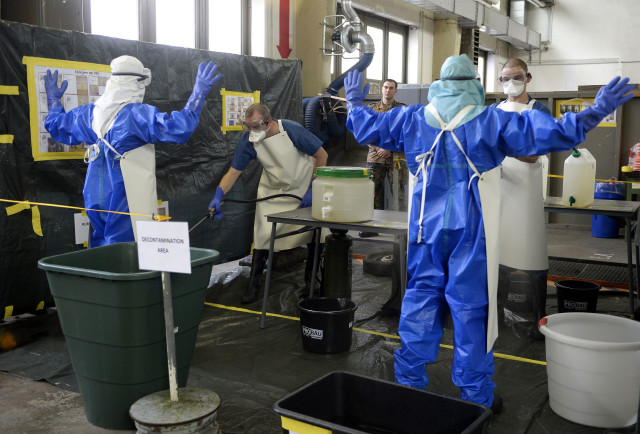
Volunteers of German army Bundeswehr, wearing protective suits, are decontaminated during an Ebola training session at the Marseille barracks in Appen, Oct. 23, 2014. (Reuters)
As global efforts to contain Ebola accelerate, U.S. researchers and robotics experts are meeting (November 7) to identify tech solutions to protect health workers tackling Ebola, which has claimed more than 4,900 lives.
The Workshop on Safety Robotics for Ebola Workers is a multi-location collaboration between Texas A&M University, the University of California at Berkley, the Worcester Polytechnic Institute in Massachusetts and the White House Office of Science and Technology.
Chairing the simulcast is Robin Murphy, Director of the Center for Robot-Assisted Search and Rescue at Texas A&M University.
She talked to TECHtonics about what participants hope to achieve.
Q. What is the purpose of this workshop?
MURPHY: We’re looking at how robots can be used for Ebola … What are the operational constraints? Who’s going to be using it? How are you going to get it there? … What are things that would impact whether robots can actually be used?
… We all can have very different assumptions about the working environment, about the training of the person who’s going to use it, the frequency of use, sometimes the cost, the maintenance cost, things like that. So we want to be sure also to work through some of those issues at this workshop as well so that we can really help companies apply their technology.
Q. Who are the participants?
MURPHY: … It’s … a group of medical experts, medical and response experts. Texas A&M is home to Texas Taskforce 1, which also includes a medical team … So we are bringing in those researchers in robotics and related technologies … sensors, biomedical, as well as industry partners from all over the country.
Q. What kind of technologies are you looking for?
MURPHY: … We’ve identified nine different uses of robots just based on what the medical professionals are telling us right now. So one of the key issues is how do you reduce the number of people that need to touch a body, a deceased person? And so [there is a] need for mortuary robots to … help carry bodies out and help with the burial so that you don’t have extra people who have to suit up and then create waste.
…. The patients have a lot of biohazards. To think of all of those suits to change in and out of – that is in itself creating waste and hazard. And how do you keep people from touching them, [searching] out ways to reducing the number of people that have to put up a suit just so they can carry out the trash and the biohazard?
Another issue: can you use robots for telepresence? … We’ve seen … doctors consulting, but also helping to inspect the decontamination process … We’ve already seen robots being used that use RV light to disinfect hospitals to help kill the germs. What does that take to help … remediate a house or a home or a hospital room that’s been contaminated? What about things like taking your vaccine and your medical processes in this field? So…. the automation that you see that we’ve been very good about in industry – can that be transferred?
Q. What does it cost to make these technologies available to developing countries fighting Ebola?
MURPHY: Regardless of whether this is happening in a developing nation or here, nobody can afford an infinite amount of cost. And that’s another reason [for] this workshop. We are trying to figure out … the bottlenecks … that cause the process to be flawed, where does it present the most risk to the workers? And how do we reduce those risks in a cost-effective way?
Adding a $2 million robot that can only be used for two hours and has a high maintenance and recharge time is not going to be effective because not only is it going to be expensive, but it’s going to be a pain to use.
Q. And yet, Isn’t the world more reactive to these types of crises than being a step ahead?
MURPHY: We are hoping … to not only identify a set of technologies that can be used within two months but also what are the barriers? What are the open research questions that we need to get robots that would be useful at the next epidemic – things that may take three to five years of R&D investment?
We’ve got to quit being reactive, particularly when we know it’s coming, we know there will be more pandemics.
